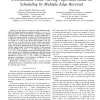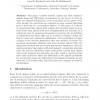1523 search results - page 161 / 305 » The Computational Complexity of Linear Optics |
GLOBECOM
2007
IEEE
14 years 4 months ago
2007
IEEE
—In most of the existing space–time code designs, achieving full diversity is based on maximum-likelihood (ML) decoding at the receiver that is usually computationally expensiv...
ISPDC
2005
IEEE
14 years 3 months ago
2005
IEEE
Abstract— In this article, we propose a fully distributed algorithm for finding all primes in an given interval [2..n] (or (L, R), more generally), based on the SMER — Schedul...
ESORICS
2004
Springer
14 years 3 months ago
2004
Springer
This paper considers iterated ciphers and their resistance against linear and differential cryptanalysis. In the theory of these attacks one assumes independence of the round keys...
AUTOMATICA
2008
13 years 10 months ago
2008
Fitting data by a bounded complexity linear model is equivalent to low-rank approximation of a matrix constructed from the data. The data matrix being Hankel structured is equival...
CGF
2005
13 years 10 months ago
2005
Current surface-based methods for interactive freeform editing of high resolution 3D models are very powerful, but at the same time require a certain minimum tessellation or sampl...


